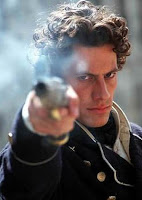 Isn’t it odd when one’s interests intersect?
Isn’t it odd when one’s interests intersect?
Here, for example, is Ioan Gruffudd:
First, as the Regency-era Wilberforce in the film Amazing Grace…
Then as the Regency-era Horatio Hornblower:
Very Regency. Very appropriate for this blog.
Of course, when Ioan played Horatio Hornblower, he had a sidekick: Archie Kennedy. Hornblower was sort of young and sweet, and Archie was even more so.
Here’s Archie Kennedy, played by Jamie Bamber. (Doesn’t he look scared and noble, and very, very young?)
There. Still very Regency. Very appropriate for this blog.
This past Sunday, my interests intersected in an interesting manner!
I went to a science fiction media fan convention… And Jamie Bamber was there.
Jamie Bamber, you say? Our Archie, at a science fiction convention?
Why, yes, of course. He is no longer sweet little Archie. Jamie Bamber has been hitting the weight room, and he now plays the military hotshot Apollo, on the new Battlestar Galactica.
Jamie Bamber has been hitting the weight room, and he now plays the military hotshot Apollo, on the new Battlestar Galactica.
Here’s Apollo:
Yes, he’s definitely been working on those muscles. (Not that I noticed or anything.)
At the convention, he actually talked about Horatio Hornblower, too! He said that had been his first acting job ever. (See? This post is highly relevant to the Regency!)
I noticed one other link to the Regency at the convention… Doug Jones, an actor who most often performs underneath intricate masks and make-up (he played Pan in Pan’s Labyrinth, for example), was there, talking about his upcoming role as the Silver Surfer in the Fantastic Four sequel.
 And The Fantastic Four, of course, stars Ioan Gruffudd as Reed Richards, a.k.a. Mr. Fantastic.
And The Fantastic Four, of course, stars Ioan Gruffudd as Reed Richards, a.k.a. Mr. Fantastic.
Ooh. Looks like maybe he’s been hitting the weight room too. (Not that I noticed.)
Now, for those of you who will think this whole post is highly juvenile, and beneath the dignity of this blog — not that I’m mentioning any names (Janet) — I’ll just say, it’s very Regency.
In fact, I’m being remarkably restrained. Regency men “stripped to advantage” — and it’s not like I put a picture of Jamie Bamber shirtless here, or anything.
Can’t think how that happened.
Oh, it must be blogger acting up again.
Yeah, that’s it. Blogger did it.
Not my fault.
I had nothing to do with it.
So… Who’d have pictured our little Archie, sweet sidekick Archie, even more sweet and vulnerable than sweet-little-Horatio-Hornblower Archie, all grown up and looking like that?
So, here are your questions for the day: (answer any or all):
1) Why do so many Regency writers also read and write science fiction? Why do science fiction conventions have Regency dance? What is the connection?
2) Who’s cuter, Jamie Bamber or Ioan Gruffudd? (And how do they compare with Clive Owen, Matthew Macfadyen, and Gerard Butler?)
All answers welcome!
Cara
Cara King, author of MY LADY GAMESTER, in which hunky Lord Stoke never takes off his shirt






